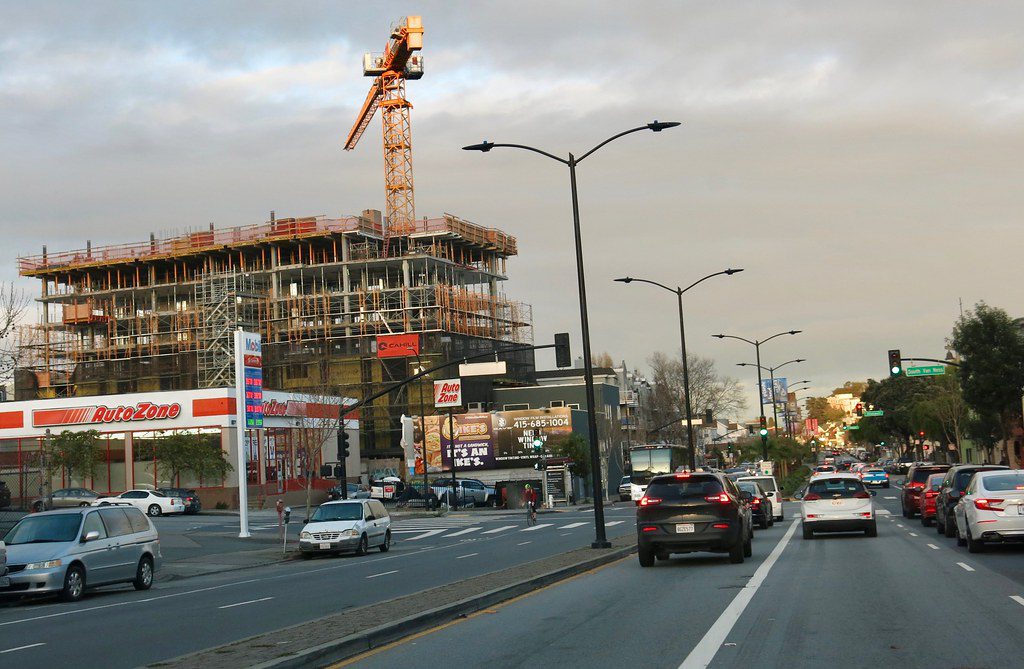
Construction of the 1296 Shotwell development looms over the Mission District. Photo by flickr user torbakhopper, CC-BY-N.D. 2.0
The question of integrating affordable housing units required by inclusionary zoning on-site versus allowing developers to pay a fee to locate them off-site has long been a contentious one. In this Q&A, Sam Moss, executive director of the Mission Housing Development Corporation in San Francisco, explains why he thinks that the fee-out option is unfairly demonized.

Sam Moss, executive director of Mission Housing Development Corporation
Miriam Axel-Lute: Last year on social media you posted saying something to the effect of, “Hey, look: everybody talks about on-site units as the holy grail of inclusionary zoning, but I think off-site fees are actually better.” Why do you think people go for the on-site units, and why do you think that off-site is better?
Sam Moss: If a developer chooses to fee out, [and if that fee is] properly disseminated to nonprofit affordable housing developers through something like a housing trust fund or an affordable housing fund, that is the most efficient, most valuable use of the fee. Building on-site is supported by a lot of people, mainly because of how long it takes to build the 100 percent–affordable projects. It can take years longer than the market-rate project that produced the fee. There is something to be said for getting below-market-rate units built at the exact same time as the market-rate development.
But at the end of the day, using the fees on affordable housing nonprofits leverages each dollar into $3 or so, because of tax credits and bonds and things like that. I believe that’s the most valuable use.
[Why do I think that off-site is] better? I don’t know that it’s necessarily better. [But] I am disappointed and frustrated over the demonizing of the fee-out option. I can see why people would just default to demanding on-site, but I do still believe that the most valuable, efficient use of the funds is to allow a nonprofit developer to utilize the fee.
So you’re saying more units would be built using the fee-out option?
Yes, because the nonprofit can leverage the fee dollars with other sources of funding, you essentially get more units. So, for every dollar that the market-rate developer would have spent building units on-site, that same amount of money can be utilized to, in some cases, triple the amount of overall funding that’s available for the affordable units, and thus build more units.
One of the reasons people like on-site is it can be a way to force affordable units into areas that would put up a NIMBY fight against a totally affordable development. How would you respond to this?
Mainly that is a bed that we’re sleeping in because of our zoning, and other laws. Apartment buildings in most cities are only legal, from a zoning perspective, in the low-income neighborhoods. I genuinely think that’s something we can solve with just fixing our zoning laws.
The history of public housing, affordable housing, is fraught with bad decisions and bad policy. It’s rational for someone to believe that if a developer fees out that there will be segregation.
Earlier, you also talked about the importance of the fee being managed properly and distributed promptly. Is it possible that the fee-out approach increases the likelihood of the funds not getting spent, getting put into a fund that gets raided, or similar problems?
It’s very true. There’s also a timing issue. Lots of times it’s years and years [from] when a fee is paid, or [from] when an Office of Housing of a city receives the money, [until] the affordable project that is the result of that fee breaks ground, let alone finishes. I always use the example in San Francisco of 1296 Shotwell, which is a 100 percent low-income senior development in the Mission. It’ll [open] about 10 years or so after the market-rate development [that funded] it. A decade is a really long time.
These problems with how money is distributed and how fast or slow it happens, are really where the anger and frustration are coming from.
Are there advantages to having a nonprofit affordable housing organization managing units, as opposed to units within a market-rate building?
I believe there are when we build the 100 percent–affordable development, that’s clearly a really difficult thing. But once it’s built, we provide resident and community services at the building, on the ground floor. Things like a food pantry, free computer labs, and you name it; those are provided on the ground floor of the 100 percent–affordable buildings because the original fee can be leveraged. And there’s other funds to obtain. When a unit is built on-site within the market-rate developments, there are no services, typically. That’s not the business that the market-rate developer is in, and typically there is no partnership with a nonprofit affordable developer, or even service provider.
If you were to design a policy that worked exactly how you thought it should work, what would the components be?
First and foremost, the rules would be the rules [regarding the circumstances for] when you can fee out or not fee out. [That would] institute more certainty into the way both affordable and market-rate development is built.
I would love to strengthen the way that the funds are distributed if a developer fees out. Those funds should be spent relatively close to, if not right in, the neighborhood where the market-rate development is being built, perhaps a 1- or 2-mile radius. [It] leads to the demonizing of the fee-out [when] lots of the fees are contributed to the affordable housing trust fund and then they’re spent far away from the neighborhood, in some cases at least. And community members that agreed and did not fight the fee-out, they believe that they were bait-and-switched, in the sense that the funds aren’t spent in their neighborhood. Now, it is still spent on affordable housing development and, in and of itself, that is good.
[So,] spend the money in a timely manner, relative to the market-rate development, and spend the money to support the communities where the development’s being built.
There are policies throughout the country where the market-rate developer cannot break ground on its development until the affordable fee is issued, and, in some cases, until the affordable development project that’s happening because of the fee breaks ground. That is definitely a good policy; as long as there aren’t major impediments to spending the affordable fee, then that is also something I would support.
Do you have a sense of how quick the turnaround is now, where you are?
There’s some cases where the turnaround is quick, or simultaneous with the market-rate development breaking ground. There are other cases where the funds have sat for a while and have not been distributed. But in the cases where the funds aren’t distributed, it really is a matter of other impediments. Perhaps land needs to be secured, or there isn’t a specific project for the affordable portion that lines up exactly with the market-rate. It does feel like a very long time. That’s for myriad reasons: funding, zoning, and entitlement rules. And if you are leveraging the fee, you’re using it to secure tax credits, tax-exempt bonds, cap-and-trade money, and other federal money. Those all have their own timelines for when something is built, and you can’t always line up the fee perfectly.
Do you think it makes sense to hold a market-rate development until that’s all settled?
No, that would be a difficult thing to push forward. It should be based on the funds being distributed or promised to a specific affordable development, as long as that development’s moving forward with entitlements, or some part of the process. There are ways for developers to demonstrate where this fee is going.
Anything you’d like to add?
My frustration is how much the fee is demonized, in the sense of it being [perceived] that a developer is pushing for segregation, or getting out of their liability or their responsibility to offset any gentrifying or impacting of the city. I understand why people have that opinion. But I don’t think that the hate of the fee-outs is justified.
I wish that we could just pause for a second and look at how many units are built utilizing the fee-out structure. It’s the way that the overwhelming majority of 100 percent–affordable projects are built. At least in San Francisco, [aside] from a bond that we passed, [the housing trust fund is] all in-lieu fees. If you starve the in-lieu fees, then you starve a nonprofit’s ability to even begin a new, 100 percent–affordable project. Having the Mayor’s Office of Housing commit that there will be funds available down the road is one of the most surefire ways to secure the other funds that we leverage the initial fee with.
And so if you starve the fund, you limit our industry’s way of looking towards the future, trying to buy land, and saying, “Yes, we know it’s going to take a few years to raise the funds, but we have funds.” You really limit our ability to compete with the for-profit private market, which at the end of the day is something that we really have to do.




It’s not as simple as this article makes it sound. I’m in Burlington, VT. The 40 year old Housing Trust Fund has been in trouble for years because the off-site fee is now so high a percentage the developers can’t afford it – not without raising rents on market rate units even more. And our rents are comparable to New York City.
There is the potential to use a buy-out type philosophy to allow the creation of housing for low income and especially African American families to access majority neighborhoods where it is difficult for outsiders of color to break the unspoken boundaries to middle class life. We need to make some assumptions – 1.) that the entity seeking the buyout has the financial resources to purchase middle class housing; 2.) that the entity has the skill to deal with an ongoing role managing these scattered rental homes, and 3.) there is a commitment to keeping the affordability and management requirements intact for a minimum period (e.g. something like Housing Choice Voucher terms). Baltimore has developed a counseling and referral entity to meet previous litigation, and can always need housing available to graduates of that program. Baltimore is a city with almost no gentrification. The only market rate development in the last 40 years has taken place in the regions around the City. That leaves the City with growth in two sectors – income restricted development or luxury waterfront housing. Rather than having developers put “buy-out” dollars into a unresolved pool, the actual purchase (using those same funds) by a developer could provide the extra money needed to make regional housing available to graduates of the mobility training program.